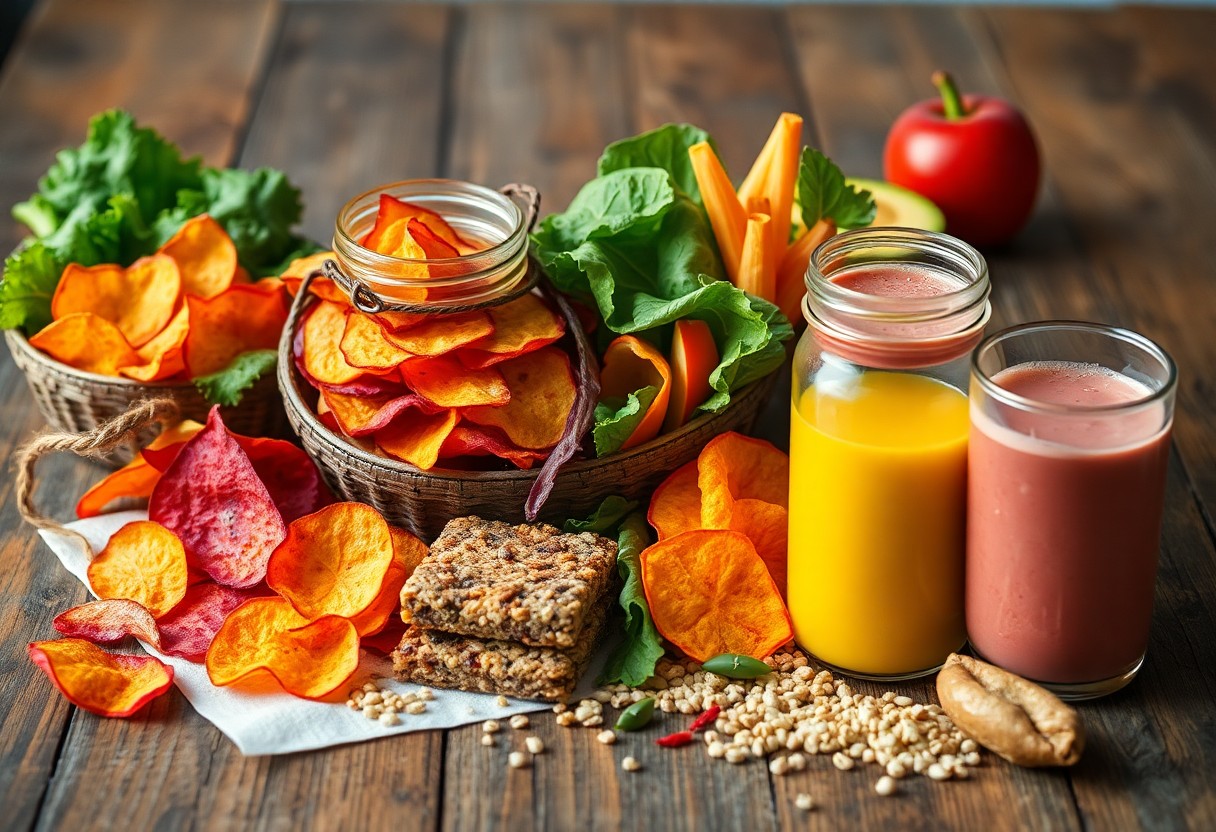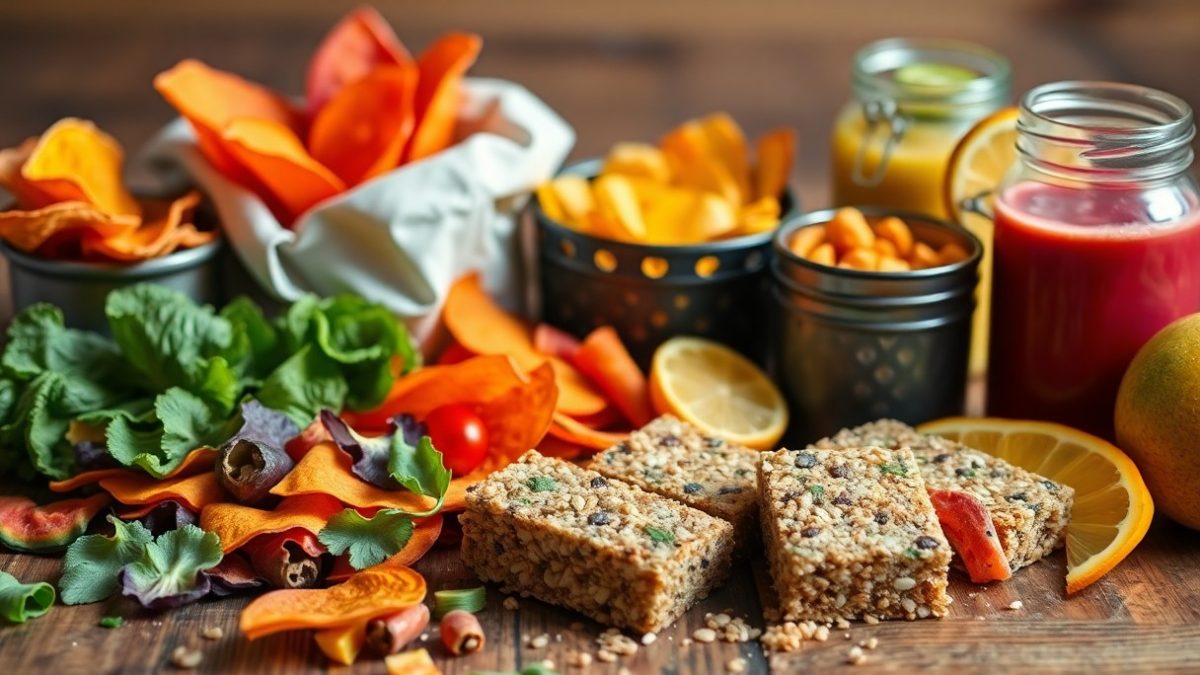Transforming Leftovers Into Delicious Healthy Snacks

Delicious One-Pot Meals For Effortless Family Dining
November 6, 2024
Quick And Easy Recipes For Busy Family Dinners
November 7, 2024It’s a common dilemma: you want to reduce food waste, but you’re not sure how to make your leftovers exciting. By creatively revamping your leftovers, you can turn them into nutritious and tasty snacks that not only satisfy your cravings but also contribute to your health journey. This guide will show you how to repurpose those uneaten meals into delightful bites, ensuring you get the most out of your food while enjoying every bite. Say goodbye to waste and hello to your new favorite snacks!
Key Takeaways:
- Creativity: Explore new flavor combinations by incorporating leftover ingredients, which can lead to unique and tasty healthy snacks.
- Nutrition: Prioritizing wholesome ingredients from leftovers not only minimizes waste but also enhances the nutritional value of your snacks.
- Convenience: Transforming leftovers into snacks saves time during meal prep, providing quick and healthy options for busy days.
Understanding Leftovers
Before you toss those remnants of last night’s dinner, consider how you can creatively transform your leftovers into exciting meals or snacks. Understanding your leftovers not only helps minimize food waste but also opens up avenues for delicious and nutritious options. With a little creativity, you can breathe new life into familiar ingredients and enjoy them in unexpected ways.
Common Types of Leftovers
With many meals come various types of leftovers. Here are some common categories:
| Cooked vegetables | Often forgotten, they can be repurposed into salads, soups, or pasta dishes. |
| Grains | Items like rice, quinoa, or pasta can be remixed into salads or stir-fries. |
| Meat | Chicken, beef, or fish can be transformed into tacos, wraps, or casseroles. |
| Soups | Leftover soup can be enhanced with fresh ingredients to create new meals. |
| Baked goods | Stale bread can be turned into croutons, bread pudding, or French toast. |
This approach not only reduces waste but also encourages you to experiment with flavors and textures.
Nutritional Benefits of Repurposing Food
Behind the act of repurposing your leftovers lies a host of health benefits. By utilizing ingredients you already have, you can create balanced meals that are nutritious and satisfying. The synergy of flavors when combining different leftovers can introduce a variety of vitamins and minerals into your diet, enhancing your overall health.
Another important aspect of repurposing food is the potential to decrease your risk of food waste, thus positively impacting the environment. When you creatively use your leftovers, not only do you save money, but you also reduce your ecological footprint. This means fewer leftovers go to the landfill, and you reap the benefits of a diverse and nutritious diet, becoming more resourceful in the kitchen.
Creative Snack Ideas
Some leftovers can be transformed into unique snacks that not only satisfy your cravings but also maximize your ingredients. Get creative with your pantry and fridge items to develop new, exciting flavors. By thinking outside the box, you can give your leftovers a second life, all while enjoying delicious and healthy snacks that keep you energized throughout the day.
Leftover Vegetable Chips
On a quest to use your extra vegetables? Turn them into crispy vegetable chips! Simply slice your leftover veggies like carrots, beets, or kale thinly, toss them with a splash of olive oil and seasonings, then bake until they are crispy. Not only do these chips provide a satisfying crunch, but they also offer a healthy alternative to traditional snacks.
Fruit and Nut Energy Bites
Bites of wholesome goodness are perfect for a quick energy boost. Using your leftover dried fruits and nuts, you can create these no-bake energy bites that are packed with flavor and nutrients. Combine ingredients like oats, nut butter, and honey; roll them into balls, and chill them for a convenient snack anytime you need a pick-me-up.
Ideas for Fruit and Nut Energy Bites can be as diverse as your pantry allows. Start with a base of rolled oats and mix in your favorite nuts such as almonds or walnuts for protein. Add a variety of dried fruits like apricots or cranberries for sweetness. You can even incorporate seeds or a sprinkle of cocoa powder for extra flavor. These bites are not only easy to make, but they provide a balanced combination of carbohydrates and healthy fats, making them a perfect snack for maintaining your energy levels throughout the day.
Innovative Recipes
Despite the common perception that leftovers are boring, they can be repurposed into exciting and nutritious snacks. With a little creativity, you can turn last night’s meal into scrumptious treats that not only reduce food waste but also elevate your snacking game. From savory wraps to sweet desserts, these innovative recipes will inspire you to redefine how you view leftovers in your kitchen.
Savory Wraps and Rolls
Above all, savory wraps and rolls are a fantastic way to use up leftover meats, vegetables, or grains. Simply take your leftovers, bundle them up in a whole-grain tortilla or lettuce leaf, and add some fresh herbs or a zesty sauce for a nutritious snack that packs flavor and texture. This versatile approach not only helps you reduce waste but also allows you to enjoy a meal on the go.
Sweet Bread Pudding Snacks
About sweet bread pudding snacks, they are a delightful way to breathe new life into stale bread. You can transform your leftovers into a rich, custardy treat by mixing the bread with eggs, milk, and a touch of cinnamon or vanilla. Bake it until golden for a comforting snack that feels indulgent yet is quite simple to make.
Plus, sweet bread pudding snacks are a wholesome alternative to store-bought desserts that often contain unnecessary additives. By using leftover bread, you’re not only minimizing waste but also saving money. Enhance your pudding with healthy mix-ins like dried fruits, nuts, or dark chocolate for added flavor and texture. This satisfying snack can be enjoyed warm or cold, providing you with a deliciously versatile option to please your taste buds.

Meal Prep and Storage Tips
Now, to maximize the potential of your leftovers, meal prep and proper storage techniques are crucial. Follow these tips for optimal results:
- Use clear, airtight containers to prevent spoilage
- Label each container with the contents and date
- Store food in portions to enhance convenience
- Keep your refrigerator at 40°F (4°C) or below
Perceiving these methods will help you transform leftovers into delightful snacks with ease.
Best Practices for Storing Leftovers
Behind the scenes, effective storage techniques can significantly extend the life of your leftovers. Always cool your food to room temperature before sealing it in an airtight container to prevent condensation, which can lead to spoilage. Utilize smaller containers to store single servings, making it easier to grab and go when snacking. Ensure your refrigerator settings are kept at the appropriate temperature for optimal freshness.
Utilizing Freezer-Friendly Snacks
Leftovers can be a game-changer when you learn how to transform them into freezer-friendly snacks. By freezing portions of dishes like soups, stews, or casseroles, you can create a treasure trove of ready-to-eat meals. This not only saves time and reduces waste but also allows you to enjoy your favorite meals throughout the week. When preparing snacks for the freezer, ensure they are cooled completely and packaged in suitable bags or containers for easy thawing. Be mindful to check for any signs of freezer burn to maintain the best flavor.
Further, when utilizing these snacks from your freezer, place them in the refrigerator overnight for a safe thaw or reheat them directly in the microwave. Make sure to consume frozen leftovers within a few months for the best taste. When reheating, avoid leaving them at room temperature for extended periods to prevent bacteria growth. The positive aspect of this practice is that not only are you minimizing food waste, but you’re also ensuring that you always have delicious, nutritious options available at your fingertips.
Incorporating Leftover Snacks into Your Diet
Not all snacks are created equal, and finding a way to incorporate your leftover snacks into your diet can boost your overall wellbeing. By thoughtfully integrating these nutritious morsels, you can create a balance between indulgence and health. It’s about making leftover snacks a convenient part of your daily routine, ensuring that they serve as more than just an afterthought when hunger strikes. Incorporating these options allows you to reduce food waste while enjoying the flavor and health benefits they offer.
Balancing Snacks with Nutritional Needs
About balancing your snacks is imperative for meeting your overall nutritional needs. Aim for snacks that complement your meals by providing necessary vitamins, minerals, and protein. When snacks contain a variety of food groups, you can help yourself feel satisfied and energized throughout the day.
Integrating Snacks into Daily Meals
Behind every successful meal plan lies a thoughtful integration of snacks that support your health goals. By mixing leftover snacks into your meals or eating them in combination with other healthy foods, you can enhance the nutritional value of your diet. With a bit of creativity, your snacks can cross over to become part of balanced meals. For instance, leftover roasted vegetables can top your morning omelet, while a healthy dip made from leftover beans can accompany fresh veggies during lunch. This way, you ensure your snacks are not only delicious but also contribute positively to your nutritional balance.
Environmental Impact of Reducing Food Waste
To make a meaningful change in combating climate change, reducing food waste is paramount. By transforming leftovers into tasty snacks, you not only minimize what ends up in landfills but also conserve resources used in food production. To learn more about How to Transform Leftover Ingredients Into 10 Delicious Go …, you can explore creative ideas that promote sustainability and showcase the positive effects you can have on the environment.
Importance of Sustainable Practices
The importance of sustainable practices cannot be overstated, especially as you seek to foster a healthier planet. By embracing techniques that minimize waste, you contribute directly to a circular economy, where your food choices help reduce environmental strain.
Benefits of Cooking with Leftovers
Waste not, want not. Cooking with leftovers offers a myriad of benefits, from saving you money to reducing your carbon footprint. When you incorporate remnants from previous meals, you not only make the best use of your resources but also foster creativity in the kitchen.
And by utilizing leftovers, you gain the advantage of cost savings—this means less spending on groceries as you maximize what you already have. Moreover, reducing food waste contributes positively to the environment, helping to lower your overall carbon footprint. Each time you transform leftovers, you are making a statement about sustainability while treating yourself to new and exciting flavors. Plus, this practice encourages a more mindful approach to cooking, allowing you to innovate and experiment while honoring the resources available to you.
Summing up
To wrap up, transforming leftovers into delicious healthy snacks not only minimizes food waste but also allows you to enjoy nutritious and flavorful options with minimal effort. By utilizing creative recipes and incorporating various food groups, you can make the most out of your leftover ingredients. This practice encourages mindful eating and helps you maintain a balanced diet while saving time and money. So, get inspired and start experimenting with your leftovers to elevate your snacking game!
Q: What are some creative ways to use leftover vegetables?
A: Leftover vegetables can be repurposed into a variety of delicious healthy snacks. One easy idea is to blend them into a smoothie for added nutrients. Alternatively, roast the leftover vegetables with some herbs and spices to make a crunchy topping for salads or grain bowls. You can also mix them into eggs for a hearty omelette or frittata. Another fun option is to create vegetable patties by combining the veggies with beans and binding agents, then pan-frying them for a tasty snack.
Q: How can I turn leftover grains into a nutritious snack?
A: Leftover grains like rice, quinoa, or couscous can easily be transformed into nutritious snacks. One approach is to create grain patties by mixing the grains with vegetables and your favorite seasonings, then shaping them into small cakes and baking or frying them. You can also prepare a grain salad by tossing the leftovers with beans, chopped veggies, herbs, and a light dressing for a filling snack. Additionally, try making grain bars by combining cooked grains with nut butter and dried fruits, shaping them into bars, and refrigerating until firm.
Q: What are some healthy ways to use leftover fruit?
A: Leftover fruit can be utilized in various exciting and healthy snacks. One of the simplest ideas is to make a fruit salad by combining various fruits and adding a squeeze of lemon or lime juice for flavor. You can also blend leftover fruit into smoothies or use them as toppings for yogurt or oatmeal. Another delicious option is to bake a fruit crisp or crumble, using oats and nuts as a topping. Furthermore, consider drying excess fruit to create homemade fruit leather or chips, which make for a portable and satisfying snack.
NEWSLETTER







